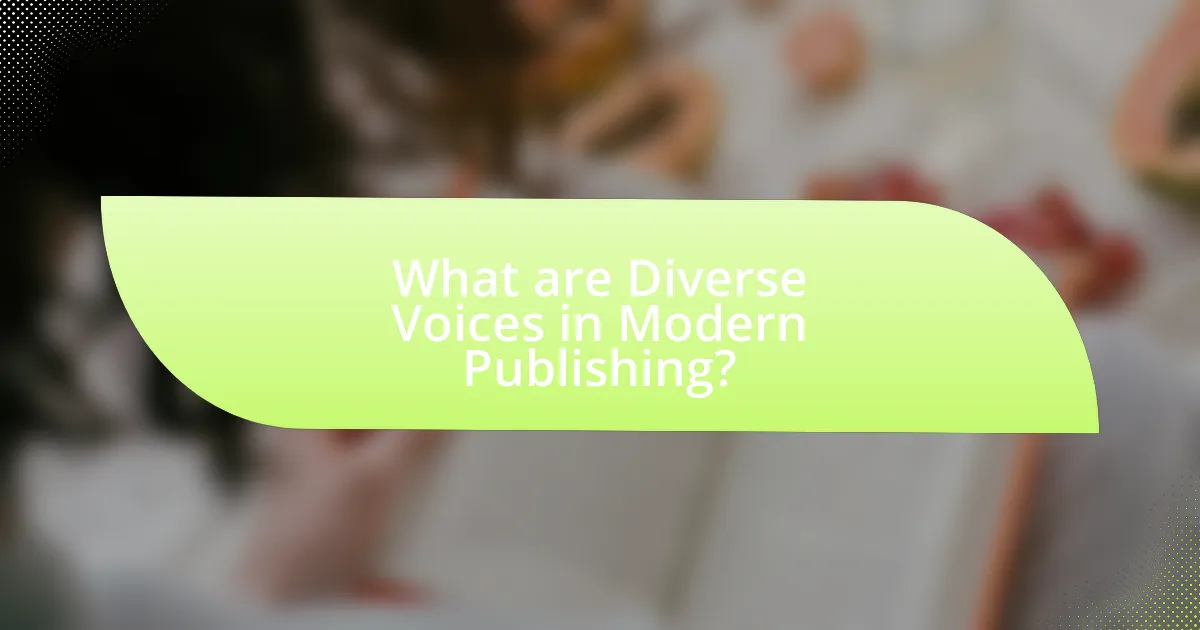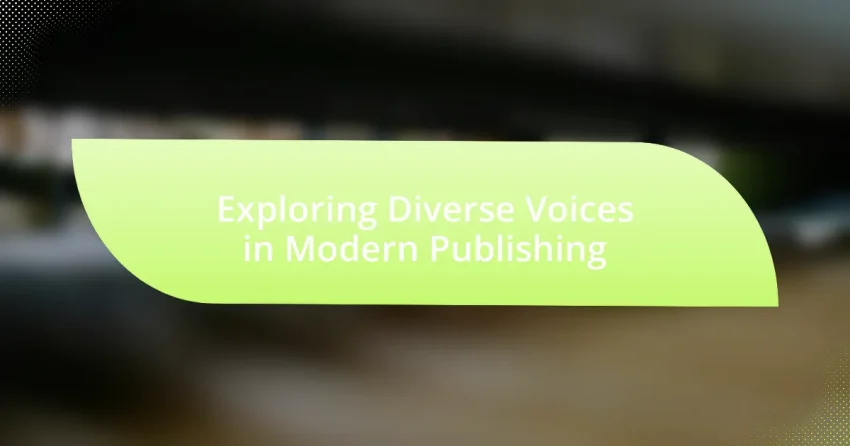Diverse voices in modern publishing encompass the inclusion of authors and narratives from a variety of backgrounds, particularly those historically marginalized. This article examines the importance of diversity in the publishing industry, highlighting its impact on storytelling, representation, and market growth. It discusses the challenges faced by diverse authors, including systemic bias and limited access to resources, while also outlining initiatives and strategies to promote inclusivity. Key players advocating for diverse voices, such as organizations and authors, are identified, along with the roles of publishers, literary agents, and readers in fostering a more equitable literary landscape.

What are Diverse Voices in Modern Publishing?
Diverse voices in modern publishing refer to the inclusion of authors and narratives that represent a wide range of backgrounds, cultures, and experiences, particularly those historically marginalized or underrepresented. This movement aims to enrich the literary landscape by showcasing stories from various ethnicities, genders, sexual orientations, and socio-economic statuses. Research indicates that diverse representation in literature can enhance empathy and understanding among readers, as highlighted in the 2019 report by the Cooperative Children’s Book Center, which found that only 28% of children’s books published in 2018 featured characters of color. This underscores the ongoing need for diverse voices to ensure that literature reflects the complexity of society.
Why is diversity important in the publishing industry?
Diversity is important in the publishing industry because it ensures a wide range of perspectives and experiences are represented, which enriches the literary landscape. A diverse publishing environment allows for stories from various cultural, social, and economic backgrounds to be told, fostering greater empathy and understanding among readers. Research indicates that diverse books can lead to increased sales; for instance, a 2019 study by the Cooperative Children’s Book Center found that only 28% of children’s books published in 2018 featured characters of color, highlighting a significant gap in representation. This lack of diversity can alienate potential readers and limit the market’s growth. Therefore, promoting diversity in publishing not only reflects societal realities but also drives economic success by appealing to a broader audience.
How does diversity impact storytelling and representation?
Diversity significantly enhances storytelling and representation by introducing varied perspectives and experiences that enrich narratives. When stories reflect a wide range of cultural, social, and personal backgrounds, they resonate more deeply with diverse audiences, fostering empathy and understanding. Research indicates that inclusive representation in media can lead to increased engagement and satisfaction among viewers, as seen in studies by the Geena Davis Institute on Gender in Media, which found that films with diverse casts perform better at the box office. Furthermore, diverse storytelling challenges stereotypes and promotes social change, as evidenced by the success of works like “The Hate U Give” by Angie Thomas, which addresses racial issues and has sparked important conversations.
What are the consequences of a lack of diversity in publishing?
A lack of diversity in publishing leads to a narrow representation of voices and perspectives, resulting in a homogenized literary landscape. This lack of variety can perpetuate stereotypes and limit the cultural understanding of readers, as they are exposed primarily to a singular viewpoint. Research indicates that diverse narratives enhance empathy and critical thinking among audiences; thus, their absence can hinder societal progress and inclusivity. For instance, a study by the Cooperative Children’s Book Center found that in 2018, only 28% of children’s books published featured characters of color, highlighting the significant gap in representation. This underrepresentation not only affects readers’ experiences but also impacts authors from marginalized backgrounds, who may struggle to find opportunities to publish their work.
Who are the key players advocating for diverse voices?
Key players advocating for diverse voices include organizations like We Need Diverse Books, which promotes literature that reflects the diversity of the world. Additionally, authors such as Chimamanda Ngozi Adichie and Jason Reynolds actively speak on the importance of representation in literature. Publishers like Penguin Random House and HarperCollins have also committed to increasing diversity in their catalogs. These entities and individuals work collectively to ensure that underrepresented voices are heard and included in the publishing industry, thereby enriching the literary landscape.
What roles do authors, publishers, and readers play in promoting diversity?
Authors, publishers, and readers each play crucial roles in promoting diversity within literature. Authors contribute by creating diverse characters and narratives that reflect various cultures, experiences, and perspectives, thereby broadening the literary landscape. Publishers support this diversity by actively seeking and promoting works from underrepresented voices, ensuring that a variety of stories reach the market. Readers play a vital role by choosing to engage with and support diverse literature, which encourages publishers to continue investing in such works. Research indicates that diverse representation in literature can enhance empathy and understanding among readers, highlighting the importance of these roles in fostering an inclusive literary environment.
How do literary agents contribute to the representation of diverse voices?
Literary agents contribute to the representation of diverse voices by actively seeking and promoting works from underrepresented authors. They play a crucial role in identifying talent from various cultural, ethnic, and social backgrounds, which helps diversify the literary landscape. For instance, agents like Jennifer Chen Tran have been noted for their commitment to amplifying marginalized voices, thereby increasing the visibility of diverse narratives in mainstream publishing. This effort is essential, as research indicates that diverse representation in literature can lead to broader societal understanding and empathy, making the role of literary agents vital in fostering inclusivity within the publishing industry.

How is Diversity Being Addressed in Modern Publishing?
Diversity in modern publishing is being addressed through increased representation of marginalized voices, inclusive hiring practices, and the promotion of diverse narratives. Publishers are actively seeking to amplify authors from various backgrounds, including racial and ethnic minorities, LGBTQ+ individuals, and people with disabilities. For instance, the #OwnVoices movement encourages stories told by authors who share the same marginalized identity as their characters, ensuring authenticity in representation. Additionally, industry initiatives like the We Need Diverse Books campaign advocate for more inclusive publishing practices and provide resources to support diverse authors. According to a 2021 report by the Cooperative Children’s Book Center, only 27% of children’s books published in 2020 featured characters of color, highlighting the ongoing need for improvement in diversity.
What initiatives are in place to support diverse authors?
Numerous initiatives exist to support diverse authors, including mentorship programs, grants, and publishing partnerships. For example, organizations like We Need Diverse Books provide resources and funding to promote underrepresented voices in literature. Additionally, the Author Guild offers grants specifically aimed at authors from marginalized backgrounds to help them publish their work. These initiatives are designed to address the historical disparities in publishing and ensure a broader range of perspectives in literature.
How do mentorship programs help emerging diverse writers?
Mentorship programs help emerging diverse writers by providing guidance, support, and networking opportunities that are crucial for their development. These programs connect writers with experienced mentors who can offer personalized feedback on their work, helping to refine their writing skills and navigate the publishing landscape. Research indicates that mentorship can significantly enhance a writer’s confidence and visibility; for instance, a study by the National Endowment for the Arts found that mentorship increases the likelihood of publication and success in the literary field for underrepresented writers. Additionally, mentorship fosters a sense of community, allowing diverse writers to share their unique perspectives and experiences, which enriches the literary world as a whole.
What role do grants and funding play in promoting diverse literature?
Grants and funding are crucial in promoting diverse literature by providing financial support to underrepresented authors and projects that might otherwise lack resources. This financial backing enables writers from diverse backgrounds to publish their work, thereby enriching the literary landscape with varied perspectives and narratives. For instance, organizations like the National Endowment for the Arts allocate funds specifically for projects that promote cultural diversity, which has led to an increase in the publication of works by marginalized voices. Additionally, funding initiatives often target specific demographics, ensuring that literature reflects a broader spectrum of human experience, which is essential for fostering inclusivity in the publishing industry.
How are publishing houses adapting to include diverse voices?
Publishing houses are adapting to include diverse voices by actively seeking out and promoting authors from underrepresented backgrounds. This shift is evident in initiatives such as mentorship programs aimed at marginalized writers, partnerships with diverse literary organizations, and the establishment of imprints dedicated to amplifying voices from various cultures and communities. For instance, major publishers like Penguin Random House and HarperCollins have launched specific programs to support authors of color, resulting in a measurable increase in the publication of diverse titles. According to a 2021 report by the Cooperative Children’s Book Center, the percentage of children’s books by authors of color rose from 22% in 2019 to 30% in 2020, highlighting the industry’s commitment to inclusivity.
What changes are being made in editorial practices to support diversity?
Editorial practices are increasingly incorporating diversity by implementing inclusive hiring policies, diversifying content selection, and promoting underrepresented voices. These changes aim to create a more equitable publishing landscape. For instance, many publishing houses are actively seeking editors and staff from varied backgrounds to ensure a range of perspectives in decision-making processes. Additionally, initiatives such as mentorship programs for writers from marginalized communities are being established to support their entry into the industry. Research by the American Association of Publishers indicates that diverse teams lead to more innovative ideas and better market performance, reinforcing the importance of these editorial changes.
How do marketing strategies evolve to reach diverse audiences?
Marketing strategies evolve to reach diverse audiences by incorporating inclusive messaging, utilizing data analytics, and leveraging multiple platforms. Inclusive messaging ensures that marketing content resonates with various cultural backgrounds, reflecting the values and experiences of different groups. Data analytics allows marketers to identify and understand the preferences and behaviors of diverse demographics, enabling targeted campaigns that speak directly to those audiences. Additionally, leveraging multiple platforms, such as social media, podcasts, and community events, helps to engage diverse audiences where they are most active. For instance, a study by McKinsey & Company found that companies with diverse leadership teams are 33% more likely to outperform their peers in profitability, highlighting the importance of adapting strategies to include diverse perspectives.

What Challenges Do Diverse Voices Face in Publishing?
Diverse voices in publishing face significant challenges, including systemic bias, limited access to resources, and a lack of representation in decision-making roles. Systemic bias manifests in the form of stereotypes and preconceived notions about what constitutes a marketable story, often sidelining narratives from marginalized communities. Limited access to resources, such as funding and mentorship, restricts opportunities for diverse authors to develop and promote their work. Furthermore, the underrepresentation of diverse individuals in editorial and publishing positions perpetuates a cycle where these voices are not prioritized, leading to fewer opportunities for publication and visibility. According to a 2021 report by the Cooperative Children’s Book Center, only 11% of children’s books published in 2020 were written by authors of color, highlighting the ongoing disparities in the industry.
What barriers exist for diverse authors in the publishing process?
Diverse authors face significant barriers in the publishing process, including systemic bias, lack of representation, and limited access to resources. Systemic bias manifests in the preference for established authors and mainstream narratives, which often marginalizes diverse voices. According to a 2021 report by the Cooperative Children’s Book Center, only 11% of children’s books published in 2020 featured authors of color, highlighting the lack of representation in the industry. Additionally, diverse authors frequently encounter challenges in securing literary agents and publishing deals due to preconceived notions about marketability and audience appeal. These barriers collectively hinder the visibility and success of diverse authors in the publishing landscape.
How does bias affect the selection and promotion of diverse works?
Bias significantly impacts the selection and promotion of diverse works by favoring mainstream narratives and underrepresenting marginalized voices. This occurs because decision-makers in publishing often unconsciously prioritize familiar themes and authors, leading to a lack of diversity in the types of works that receive attention and resources. For instance, a study by the Cooperative Children’s Book Center found that in 2018, only 28% of children’s books published featured characters of color, highlighting the disparity caused by bias in the industry. Such biases not only limit the visibility of diverse authors but also perpetuate stereotypes and narrow the cultural landscape available to readers.
What are the financial challenges faced by diverse authors?
Diverse authors face significant financial challenges, primarily due to limited access to publishing opportunities and resources. Research indicates that authors from marginalized backgrounds often encounter systemic barriers, such as lower advances and fewer marketing budgets compared to their mainstream counterparts. For instance, a study by the Authors Guild in 2021 revealed that authors of color earn significantly less than white authors, with 61% of authors of color reporting income below the poverty line. Additionally, diverse authors frequently struggle with representation in the industry, leading to fewer opportunities for book deals and promotional support, which further exacerbates their financial instability.
How can these challenges be overcome?
To overcome challenges in exploring diverse voices in modern publishing, publishers must implement inclusive hiring practices and actively seek out underrepresented authors. Research indicates that diverse teams produce more innovative ideas and better reflect the audience’s demographics, enhancing market reach. For instance, a study by the Cooperative Children’s Book Center found that books by authors of color increased by 20% from 2018 to 2019, demonstrating a growing recognition of the importance of diverse narratives. Additionally, establishing mentorship programs for marginalized writers can provide essential support and guidance, fostering a more equitable publishing landscape.
What strategies can authors employ to navigate the publishing landscape?
Authors can employ several strategies to navigate the publishing landscape effectively. First, they should research and understand the various publishing options available, including traditional publishing, self-publishing, and hybrid models, as each has distinct advantages and challenges. For instance, traditional publishing often provides wider distribution and professional support, while self-publishing offers greater creative control and higher royalty rates.
Additionally, authors should build a strong online presence through social media and author websites to engage with potential readers and industry professionals. Networking with other authors, attending literary events, and joining writing groups can also provide valuable insights and opportunities.
Furthermore, understanding market trends and reader preferences can help authors tailor their work to meet demand. For example, data from the Association of American Publishers indicates that genres like romance and thriller consistently perform well, guiding authors in their writing choices.
Finally, authors should consider seeking representation from literary agents who can provide guidance and facilitate connections within the industry, enhancing their chances of success in a competitive market.
How can readers support diverse voices in literature?
Readers can support diverse voices in literature by actively seeking out and purchasing books written by authors from underrepresented backgrounds. This action directly contributes to the visibility and financial success of these authors, which is essential for fostering a more inclusive literary landscape. According to a 2021 report by the Cooperative Children’s Book Center, only 27% of children’s books published in 2020 were by authors of color, highlighting the need for increased support. By prioritizing these works, readers not only enrich their own reading experiences but also help to challenge the dominant narratives in publishing, ultimately promoting a broader range of perspectives in literature.
What are the best practices for fostering diversity in publishing?
The best practices for fostering diversity in publishing include implementing inclusive hiring practices, promoting diverse authors, and creating equitable access to publishing resources. Inclusive hiring practices ensure that publishing teams reflect a variety of backgrounds, which can lead to a broader range of perspectives in decision-making. Promoting diverse authors involves actively seeking out and supporting writers from underrepresented communities, which can enhance the richness of the literary landscape. Additionally, creating equitable access to publishing resources, such as mentorship programs and funding opportunities, helps to level the playing field for aspiring authors. Research indicates that diverse teams produce more innovative outcomes, highlighting the importance of these practices in the publishing industry.
How can publishing professionals create inclusive environments?
Publishing professionals can create inclusive environments by actively promoting diverse voices and perspectives in their content and decision-making processes. This can be achieved through implementing equitable hiring practices, ensuring representation in editorial teams, and prioritizing the acquisition of works from underrepresented authors. Research indicates that diverse teams lead to better decision-making and innovation, as highlighted in a study by McKinsey & Company, which found that companies in the top quartile for gender diversity on executive teams were 21% more likely to experience above-average profitability. By fostering an inclusive culture, publishing professionals not only enhance creativity but also reflect the diverse readership they serve.
What role does community engagement play in promoting diverse literature?
Community engagement plays a crucial role in promoting diverse literature by fostering connections between authors, readers, and cultural communities. This engagement encourages the sharing of varied perspectives and experiences, which enriches the literary landscape. For instance, community-led book clubs and literary events often highlight works from underrepresented authors, increasing visibility and readership. Research indicates that initiatives like the We Need Diverse Books campaign have successfully mobilized communities to advocate for diverse narratives, resulting in a measurable increase in the publication of books that reflect a wider array of voices.
